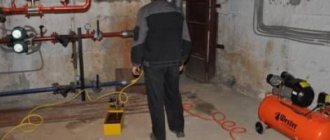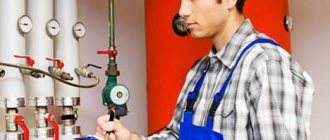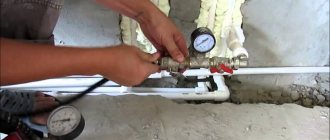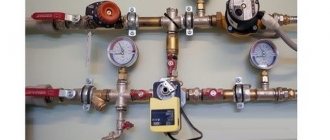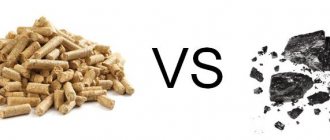Document year: 2019
Document group: Acts
Type of document: Act
Download formats: DOC, PDF
Test reports are drawn up in the form of document forms in which the results of testing the performance of mechanisms and equipment are recorded.
In today's article, we will consider in detail the testing of pipeline systems, sewerage systems, stairs and stepladders, roof fencing and fire tests.
Examples of drafting acts can be downloaded for free at the end of the article.
Hydraulic testing report for the heating and water supply pipeline system
Checks of heating and plumbing systems are carried out:
- when introducing new engineering communications;
- when reconstructing an existing one;
- during a routine check of the functioning of the system.
The step-by-step inspection and its results are recorded in the test report. The system is tested for tightness and strength in two ways, one of which is the hydraulic method: testing by using water with increased load. This method is suitable for indoor and outdoor systems (at temperatures not lower than +5C). The second method is pneumatic.
Both methods of acceptance testing are called pipe testing.
The results of the inspections are recorded in a report, the form of which is established by the Code of Rules for building codes and regulations. The template is presented in Appendix 1 to SANPin “External networks and structures of water supply and sewerage.” The presented form of the act is mandatory.
Procedure for drawing up the act:
1. Indication of general organizational information: city of compilation and date.
2. Representation of the members of the commission that carried out the pressure testing and acceptance of the pressure pipeline. Three parties become members:
| The company that installed the pipeline |
| Technical supervision representative from the customer |
| Operating company representative |
3. Below is information about the inspected object and a description of the pipeline (length, diameter, material of pipes and joints), information specified in the working documentation is given, and information about the pressure gauge used is given.
4. The section about the test and its results is completed.
5. In the section “Decision of the commission” there is a statement that the system is considered strong and airtight and this is signed by the members of the commission.
You can download the form for free at the end of the article.
Pipe crimping
As you can easily guess from the title of the article, its topic will be pipe crimping - what crimping is, why it is done and what tools are needed for it.
Crimping: a concept in a broad sense
The very concept of “pressure testing” in relation to metal-plastic hoses should be considered in the broad sense of the word. For example, pressure testing often refers to standard tests carried out hydraulically or pneumatically.
But modern practice shows that the term “pressure testing” also quite logically fits the procedure for connecting a fitting and a metal-plastic pipe. This type of connection is made using power crimping technology using a special tool (press pliers).
The photo shows the moment of crimping during the process of joining metal-plastic pipes. In this case, crimping is a mechanical force action aimed at achieving tightness of a reliable connection
Regardless of the installation conditions and the technologies used, the installation of water supply or other communications based on metal-plastic pipes is accompanied by tests for tightness and strength.
This is approximately what the connection point for a pressure testing pump to a water supply system on metal-plastic pipes looks like. One of two control pressure gauges is installed at the inlet, which determines the tightness of the circuit
Typically, the testing process is carried out hydraulically. But the possibility of testing using the pneumatic method is not excluded.
Conclusion
: Pressure testing of the heating main - let's look at the main thing
Introduction. up
The purpose of this article is to describe the procedures for pressure testing (pressure testing) of installed pipes and connections of the heating and water supply system to check the quality of the work performed.
The general principles of the hydrostatic (water pressure testing) and manometric (air pressure testing) methods are described.
Specific recommendations from leading manufacturers of polymer pipelines, which are often used in the installation of heating and water supply in private homes, are considered: Uponor, Rehau, Herz, Kan. Sets out local codes and regulations regarding pressure testing.
What is pressure testing of pipelines and connections. up
After installing pipelines and connections of elements of heating and water supply systems, it is necessary to check the quality of installation work and make sure there is no damage or poorly installed elements.
Such tests must be carried out before and immediately during the embedding of elements of engineering systems into the building structures (pouring floor screeds, plastering grooves, sewing niches, etc.).
This procedure allows you to promptly notice and eliminate accidental damage, reducing the likelihood of the so-called manifestation. "human factor".
A self-tapping screw accidentally screwed into a pipe laid in the wall or a sharp nail on a shoe when pouring heated floor pipes, or a pipe damaged during transportation or installation can (and often does) go unnoticed if pressure testing has not been carried out. During commissioning, these damages still make themselves felt and require expensive repairs, incl.
and to restore the fine finishing of the premises (replacing tiles, plastering, puttying, painting, wallpapering, etc.).
Pressure testing of pipes can be carried out either with water (the working medium - which is preferable) or, in some cases, with air. Checking pipelines with air is most often carried out when the ambient temperature drops below +5°C and there is a risk of water pipes freezing.
The methods for testing heating and water supply systems with water (hydrostatic tests) and air (manometric tests) are somewhat different (see below).
The test pressure should be selected based on the test medium (water or air), the operating pressure of the piping system, the pipe manufacturer's recommendations, and local codes.
Conclusion
I think we have fully answered the question of what pipe crimping is and why it is needed. The choice of a specific tool is up to you. Good luck!
Certificate of pneumatic testing of pipelines
Pneumatic method: diagnosis by pumping the system with high pressure air. Often the method is used for external systems if the temperature on the thermometer is less than +5 Celsius.
The procedure for crimping pipes by pneumatic testing is given in the same SanPiN; the test report is drawn up in the required form, which is given in Appendix No. 3.
Requirements for drawing up test documentation:
- Filling in the name of the city and the date of compilation.
- Indication of the members of the commission (as in the hydraulic test, three parties are involved).
- Description of the pipeline: length, diameter, material of pipes and joints.
- Information about the pressure value: calculated value, to what value the pressure in the pipes was increased, final pressure, amount of reduction. The crimping time is indicated.
- In the “Decision of the Commission” section, each of its members signs with a transcript if the pipeline has passed pneumatic diagnostics and is sealed and durable.
Requirements for standards for hydrotesting of heating
According to document SNiP 41-01 of 2003, a similar process for water heating systems is allowed to be carried out at above-zero temperatures in the building. The system must function as efficiently as possible and withstand a fluid pressure of 0.6 MPa, otherwise depressurization and damage to some components cannot be avoided.
Pipelines and fittings together with devices should not be subjected to the maximum pressure values that were provided for during installation. Hydrostatic tests assume the use of a load equal to 1.5 times the operating state of the system, but not less than 0.2 MPa, in relation to the lower part of the pipeline.
The work can be considered successful if all communications last for 10 minutes; the pressure during this period should not drop by more than 0.02 MPa.
Certificate of testing of external and internal sewerage for spillage
A test report for internal and external sewerage is drawn up as a result of checking the operability of the system. It confirms the position of the commission that the system has withstood the test of a spill of water, and the design complies with the design documentation, GOSTs and standards.
Diagnostics of the normal functionality of the sewer system is necessary when installing a new facility or after carrying out repair work on an existing system. Information about the performance check is entered into the report. The form is drawn up in the form specified in Appendix “D” to the Code of Rules 73.13330.2012.
The act specifies:
- name of the system and the facility in which it is installed;
- information about the members of the commission. Representatives of three organizations are needed: the general contractor, the customer and the installation company;
- information about the name of the project is written down;
- the results are entered: the number of simultaneously connected devices, as well as the connection time or filling of water on the floor (unnecessary ones are crossed out);
- the third paragraph states that no leaks were detected at the joints and through the walls. This means the system is suitable for use.
The decision is signed by the members of the commission.
When the work is carried out
All activities related to checking heating for leaks are carried out in the following cases:
- During preparation for the heating season;
- When replacing sections of the circuit;
- After repair of heating devices;
- When putting the property into operation.
The test procedure itself is a confirmation of the tightness of the circuit
.
This procedure includes the following components:
- Supplying air or water with a given pressure into heating pipelines using special equipment;
- Finding deformations in the heating circuit;
- Elimination of violations.
It is worth noting that modern heating schemes allow such events to be carried out with a minimum number of personnel.
Fire test reports
During testing for the performance and safe operation of fire equipment, several reports are drawn up:
- checking fire hydrants;
- diagnostics of internal water supply;
- checking for the safety of use and compliance with labor protection rules of fire escapes.
Fire hydrants
Testing the performance of hydrants for water loss is carried out twice a year and is often combined with checking the fire-fighting water supply system. Based on the results of the inspection, an act is drawn up and signed by the commission. Mandatory members: a representative of the fire inspection and a representative from the organization in which the inspection is taking place. Also, the commission may consist entirely of company employees.
The act states:
- general organizational information (information about the company, date and place of compilation);
- the main part describes the members of the commission and the progress of the test. Information about hydrants is presented in tabular form. The location address, diameter, pressure, water yield and affiliation of the hydrant are indicated;
- in the final part, compliance (or non-compliance) with the requirements of the hydrant condition is established.
At the end, the act is signed by authorized members of the commission.
Internal fire water supply
The act establishes the presence or absence of defects and malfunctions in the fire water supply system. The inspection is carried out by responsible employees of the enterprise. Frequency – at least twice a year; for flammable industries, inspections may be scheduled more often.
Internal fire water supply (IFP) is a complex system of pipes, sensors, and switches. Therefore, it is often checked by a labor protection or fire safety specialist, as well as by persons who are trained in fire safety.
The act is drawn up on letterhead or plain paper indicating the details. Be sure to register:
- information about the organization and participants of the inspection;
- information about the object being checked;
- inspection results;
- recommendations for eliminating defects and malfunctions, if any are found;
- signatures of responsible persons.
If additional documents are attached to the act, their list and name are indicated.
Fire escapes
Testing of firefighting equipment, including ladders and stepladders, is regulated by a special GOST. Inspections can be carried out by organizations that have received permission from the Ministry of Emergency Situations and have special equipment for this.
The test results are recorded in the test report. The documentation provides standard information about the organization and its details, information about the members of the commission. The main part provides information about the inspected objects (number of ladders and stepladders, their inventory numbers and affiliation with the structural unit), information about the results of inspections (absence or presence of defects). An instruction is given to eliminate the identified faults.
At the end, the act is signed by the members of the commission.
Hydropneumatic tests
As a rule, control pressure testing and washing are recommended to be carried out at the end of the heating season. If at this time it is possible to identify weak points and defects in the system, then there is a whole season ahead without heating, when repair work can be carried out. After major or routine repair work, the networks are again filled with water and re-pressurized. This is usually done in the fall.
Hydropneumatic tests are carried out in the following sequence:
- At the end of the heating season, the condition of shut-off valves, heating and elevator units, as well as heating risers is checked.
- Preventative flushing of pipelines is carried out to clear various blockages.
- During flushing, the entire line, equipment and components are inspected for leaks. If any are identified, urgent repairs are carried out.
- The condition of thermal insulation of open sections of pipelines is checked.
- Then they carry out pressure testing and fill the networks with standard coolant so that they are completely ready for the new heating season.
To carry out hydropneumatic testing, the circuit is filled with water, then an electric or manual pump is connected, and the pressure is raised to the required level. Pumping equipment must be equipped with a built-in pressure gauge.
To check the intra-house network, the pressure is increased 1.5-2 times, starting from the operating value. When testing old networks, it is enough to increase the pressure by 25-50% of the operating parameter. The test pressure indicator depends on the limit value that the devices installed in the network can withstand.
Roof fencing test report
Technical requirements and roof testing methods are enshrined in the same GOST as the standard for fire escapes and stepladders (53254-2009).
Tests are carried out at intervals of five years, integrity checks are carried out every year. The results are documented in acts.
The conditionally completed act can be divided into three parts:
- General information. Information about the tested object and the inspecting organization is entered here.
- Information about the inspection (what manipulations were carried out, what tools were used).
- Test results (compliance with GOSTs, integrity and safety of the structure).
The agreement of the commission members during testing is confirmed by their personal signatures.
Organizations with a license from the Ministry of Emergency Situations have the right to conduct inspections and tests. Defects found must be corrected.
Download documents
The question that interested our client was who is to blame if the radiator in the apartment bursts
?
The heating season did not start very well for our client. In a Stalinist house on the Taras Shevchenko embankment, in the absence of the owner of the house, a heating radiator burst
.
The first two to three weeks after heating starts lead to rupture of radiators and flooding of the apartment.
With the arrival of cold weather in Moscow, the heating season began, and with the start of heating in apartments, radiators in new buildings began to burst, who is responsible?
In the last days of September, we are all waiting for the heating to finally be turned on? It's drizzling outside, cold and damp. Because of such unpleasant weather, it’s cold in the apartment and we start to catch a cold, get sick, and wait for the heat to turn on.
Test report for ladders, racks and stepladders
Inspection and testing of racks, ladders and stepladders is carried out at least once every six or twelve months (depending on the object being tested and the material from which it is made).
Tests and checks for safe operation can be carried out by specialized organizations from outside or a commission specially created at the enterprise. At the same time, its members must be trained; an occupational safety or fire safety engineer is usually appointed as the chairman of the commission.
As a result of the diagnosis, the commission draws up a report; it is better to document it with the date of the inspection. The header indicates the name of the document, date and place of compilation. It is also important to indicate the details of the organization, list the members of the commission: their positions and full names.
In the main part, describe the tests of stepladders, ladders and racks:
- how many were checked, their inventory numbers, belonging to the workshop and department;
- what load was used and for how long;
- presence and absence of defects;
- availability of an assigned inventory number.
As a result of the test, suitability (or unsuitability) for use is established: they are safe, can withstand the required load, do not have defects in connections and fastenings, do not have sharp edges or burrs.
The signing of the act by the commission members indicates agreement with the results of the inspection.
By the way! If after this article you still have questions about how to fill out the forms, contact the site’s on-duty lawyer.
Hydropneumatic flushing
As mentioned earlier, hydropneumatic flushing of the pipeline heating system is carried out using a special pulp. This method of descaling pipes involves using a large amount of water. Houses connected to central heating or water supply use hot water circulating in pipes. If the heating system is located in a private house, then purification is carried out using cold water supply.
Hydropneumatic cleaning
When flushing the heating with hydropneumatic pressure cleaning, perform the following algorithm of actions:
- the water is forced to circulate in the opposite direction to the heating, then it is started again;
- together with the incoming liquid, compressed air is blown in using a compressor;
The resulting flow copes well with sludge, but does not sufficiently wash away salt deposits and rust formed on the walls of the pipeline and radiators. When risers are used in heating, during the process they are blocked in groups and washed. The fewer risers are included in the group, the better the radiators will be cleaned.
When cleaning the heating yourself, it is very important to carry it out until the waste liquid is as clean as possible and no longer contains rust particles or sediment.
